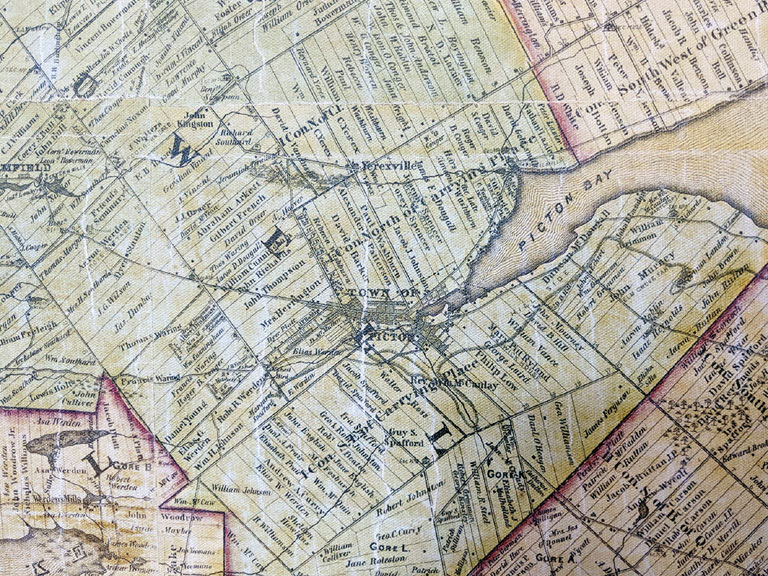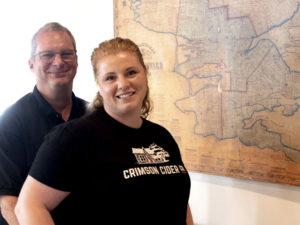County News
The Tremaine map

Historic map of the County gets new lease on life
The 1863 Tremaine map of Prince Edward County is one of the most important documents held in the County’s public archives. Originally in book form, the pages at some time in the past were glued to a canvas backing, and now hangs in the microfilm room of the Archives in Wellington. The pages have yellowed unevenly with age, and there are a few spots missing where the original pages have crumbled into dust. The map is named after George Tremaine, who operated a map publishing business in Toronto during the 1850s and 1860s, and created maps of a number of counties across Ontario for subscribers. Krista Richardson, manager of the County of Prince Edward Archives says the map holds a wealth of information. “It’s one of the earliest maps that we have that indicates the original land owners, and it shows the lots and concessions clearly laid out,” she says. “It also shows if there was a homestead on the property, so it’s useful for property history as well as our built heritage.” The map shows a dozen drawings of buildings, mostly stately residences, but also including a couple of factories—notably one that built phaetons and pleasure cutters. The map also lists over 100 County business subscribers, including one Augustus Spencer, manufacturer of washing machines, and Abraham Searles, described as “Gentleman”.

Craig Robson and Katie Klodnicki stand beside a reproduction of the Tremaine map in the Crimson Cider tasting room.
Richardson describes the map in fair to good condition for its age, and she had been trying for years to somehow create a digital copy so that it could be reprinted. She had little success until a chance meeting with Katie Klodnicki and Craig Robson. The couple had purchased an 1850s stone house on Loyalist Parkway just west of Picton, and were in the process of converting it into a tasting room for their business, Crimson Cider. They were looking into the history of the house and met Richardson at the Archives, where they discovered that their house was indicated on the map. “Krista mentioned she wanted to replicate the map so they could sell copies and raise money for a new microfilm machine,” says Klodnicki. “My first company was a photo-video company, so I offered to do it for them.” Klodnicki took numerous images of the map and digitally stitched them together using her extensive photo editing skills. The resulting file has enough detail to make a full-size (48” x 60”) reproduction.
The one significant change from the original was that Klodnicki made it appear as though all the pages had aged uniformly. The Archives is now taking orders for copies of the map, available on canvas for $250, or on vinyl for $120. The funds raised from the sale of the map will be used to purchase a new microfilm reader. A copy of the map can be seen in the Wellington Museum, or at the Crimson Cider tasting room.
However, Robson and Klodnicki were not quite done with the Archives. Their tasting room opened in late June, and the couple decided to set aside a portion of their tasting fees to be donated back to the community. “Each quarter we’ve picked a different community organization or charity, and the very first recipient of our tasting fees was the Archives,” says Klodnicki. Last Thursday, the couple presented Richardson with a cheque for $1,537.50. “I’m so overwhelmed and thankful for Katie and Craig’s donation,” says Richardson, who had to take a moment to compose herself and blink back a few tears of happiness. “Getting the program up and running with digitizing the map was more than we could have hoped for. We’ve been trying to do this for four years, and we’re so grateful. Our microfilm machines are obsolete and service calls are very expensive. We decided it was in our best interest to get a new machine, which is a very costly endeavour. So the funds we’re raising from the sale of the map, as well as money from the Friends of the Wellington Library, the Historical Society, and now very generously from Crimson Cider, will go towards the purchase of the machine.”
The cost of a new microfilm machine is over $10,000 and the Archives are now a little over halfway there with the new donation from Crimson Cider. The new machine will provide a digital output of the microfiche material, but Richardson expects that it will be mostly used for viewing the images. For more information, or to make a donation, please contact the Archives at archives@peclibrary.org, or 613.399.2023.

Comments (0)